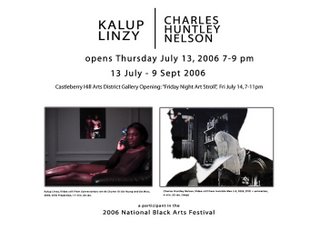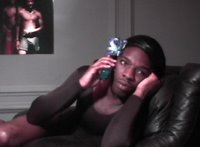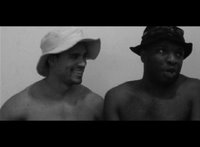Romo Gallery: Kalup Linzy + Charles Huntley Nelson July 13 - September 9, 2006

OK a little art expedition to the Castleberry Hill Arts District to see Charles Huntley Nelson and Kalup Linzy's work.
Kalup Linzy
I missed Linzy's performance when he was here in town for the NBAF, but I hoped to see some of his other work. I thought he was a photographer who was also working in video and now performance, but a little research uncovered Linzy as a filmmaker first. He also works in inks as the drawings below right show. Linzy's in his late twenties and apparently being hailed as the next big thing, well since he lives in New York, he's among however many people are allowed to be embraced as "the next big thing" at any given New York Art World Moment. In Linzy's case the enthusiasm is at times modified by the descriptors "black" and "gay" in other words "the next big black gay thing."
The resulting question of commodification and objectification is more loaded in Linzy's case because (hopefully, we can all recall Greg Tate's prose elegy, "Nobody Loves A Genius Child: Jean Michel Basquiat, Flyboy in the Buttermilk") Much of Linzy's video work combines elements of daytime television and melodrama, with plays on "race, gender, sexuality, class [you know the Kobena Mercer role call] and popular culture." In his Conversations Wit De Churen series Linzy appears in his own work as multiple characters and enlists his friends
 in co-starring and supporting roles. There is a lot of drag and gender play in his work, but costumes are worn outside of an attempt at traditional drag beauty or "realness": wigs are obvious, facial hair is past 5 o'clock shadow stage, and make up besides maybe lip gloss, is not consistently seen. As soon as an African American artist invokes folk tropes either through language, as in "De Churen" (Linzy also has a yahoo announcement list under this name), or his embodiment of truthsaying older black women questions of essentialism and minstrelsy often emerge. When artists use cultural elements that were an integral part of their upbringing, particularly deep south intonations and gestures who has the final word on the resulting art work's interpretation? As I watched Conversations Wit De Churen III: Da Young and Da Mess (2005) I was put in mind of Tyler Perry as an avant-garde video maker. Both Perry and Linzy are southern born and raised--Linzy in Florida. Both demonstrate a certain reverence for older black females, in Da Young and Da Mess this is evidenced in the portrayal of a grandmother, enacted by Linzy, who is accepting of her gay grandson, Taiwan (played by Linzy), and his new marriage-minded boyfriend, Harry (Sean Leonardo). In fact it is the grandson who is too ashamed of being gay to believe that he is
in co-starring and supporting roles. There is a lot of drag and gender play in his work, but costumes are worn outside of an attempt at traditional drag beauty or "realness": wigs are obvious, facial hair is past 5 o'clock shadow stage, and make up besides maybe lip gloss, is not consistently seen. As soon as an African American artist invokes folk tropes either through language, as in "De Churen" (Linzy also has a yahoo announcement list under this name), or his embodiment of truthsaying older black women questions of essentialism and minstrelsy often emerge. When artists use cultural elements that were an integral part of their upbringing, particularly deep south intonations and gestures who has the final word on the resulting art work's interpretation? As I watched Conversations Wit De Churen III: Da Young and Da Mess (2005) I was put in mind of Tyler Perry as an avant-garde video maker. Both Perry and Linzy are southern born and raised--Linzy in Florida. Both demonstrate a certain reverence for older black females, in Da Young and Da Mess this is evidenced in the portrayal of a grandmother, enacted by Linzy, who is accepting of her gay grandson, Taiwan (played by Linzy), and his new marriage-minded boyfriend, Harry (Sean Leonardo). In fact it is the grandson who is too ashamed of being gay to believe that he is deserving of a happy-ever-after despite the support of his grandmother and almost everyone else except for his mother (also played by Linzy) and their church community. Of the latter the grandmother comments, "most of those folks ain't even saved." Similar to Perry there are very southern elements present in the work, notable in interpersonal dynamics--particularly those of the phone conversations. It's probably no accident that the artist chose this piece to screen given this question is being raised in the context of a gay marriage ban in Georgia. The reality for a number of black LsglGBTQs is that to live fully is to loose one's biological family (or segments of it), to loose one's family of worship, to loose the relationship to people and place that make up one's self-definition. I'm making this sound rather maudlin and humorlous and it's anything but in Linzy's treatment, although it is seriously funny in many instances as Linzy looks at some hard truths in black southern life. In the end Taiwan cannot separate himself from his history, can't imagine taking the best of it and creating a new legacy. We feel the opposing hand of Linzy telling us this shame is so much fiction with the lush minimalism of the rich colors of his protagonist's furniture, the modest starlet lighting, and the changing backround of artfully lit homoerotic photographic portraits of brown and black-skinned men. Much of this drama takes place with characters talking to each other on the the phone, creating a sense of intimacy with the viewer. A solitary actor inhabits the medium and close up shots, cradling the receiver or cell phone while going about their private rituals, the suffering diva repose, the religious watching of soap operas, the dramatic and final goodbye of packing a suitcase. Despite my appreciation for Linzy's work, and queer precendent and context, I find myself feeling some discomfort with his drag images of older black women, avant-garde context or no.
deserving of a happy-ever-after despite the support of his grandmother and almost everyone else except for his mother (also played by Linzy) and their church community. Of the latter the grandmother comments, "most of those folks ain't even saved." Similar to Perry there are very southern elements present in the work, notable in interpersonal dynamics--particularly those of the phone conversations. It's probably no accident that the artist chose this piece to screen given this question is being raised in the context of a gay marriage ban in Georgia. The reality for a number of black LsglGBTQs is that to live fully is to loose one's biological family (or segments of it), to loose one's family of worship, to loose the relationship to people and place that make up one's self-definition. I'm making this sound rather maudlin and humorlous and it's anything but in Linzy's treatment, although it is seriously funny in many instances as Linzy looks at some hard truths in black southern life. In the end Taiwan cannot separate himself from his history, can't imagine taking the best of it and creating a new legacy. We feel the opposing hand of Linzy telling us this shame is so much fiction with the lush minimalism of the rich colors of his protagonist's furniture, the modest starlet lighting, and the changing backround of artfully lit homoerotic photographic portraits of brown and black-skinned men. Much of this drama takes place with characters talking to each other on the the phone, creating a sense of intimacy with the viewer. A solitary actor inhabits the medium and close up shots, cradling the receiver or cell phone while going about their private rituals, the suffering diva repose, the religious watching of soap operas, the dramatic and final goodbye of packing a suitcase. Despite my appreciation for Linzy's work, and queer precendent and context, I find myself feeling some discomfort with his drag images of older black women, avant-garde context or no.  The other work screened on a loop at Romo was the recent Lollipop (2006) which features Linzy and Sean Leonardo bare chested, their sole costuming their respective countrified hats, playfully (and skillfully) lip-syncing to "Lollipop" a 1940s era double entendre blues duet. This is conversational blues featuring a coy give-and-take about a desired "lollipop", as each performer casts lustful glances in the direction of each others off-screen laps with Linzy resisting Leonardo's mimetic entreaties for a taste of his co-star's candy until at song's end Linzy finally pulls his swirled treat into the frame licking it as Leonardo looks on with longing. According to ARTINFO's report on the 2006 Armory Show in New York, where the piece was shown by Taxter & Spengeman, the video sold for $1000 per copy and still sold out. I can definitely understand its popularity, it is on point, great capturing of the attitude of the song in a campy cruising context with a gay man who just won't give it away when he can give it to himself. Linzy has a background in broadcast production having studied mass communications at University of South Florida where he received his MFA in Visual Arts and has honed his skills doing everything himself.
The other work screened on a loop at Romo was the recent Lollipop (2006) which features Linzy and Sean Leonardo bare chested, their sole costuming their respective countrified hats, playfully (and skillfully) lip-syncing to "Lollipop" a 1940s era double entendre blues duet. This is conversational blues featuring a coy give-and-take about a desired "lollipop", as each performer casts lustful glances in the direction of each others off-screen laps with Linzy resisting Leonardo's mimetic entreaties for a taste of his co-star's candy until at song's end Linzy finally pulls his swirled treat into the frame licking it as Leonardo looks on with longing. According to ARTINFO's report on the 2006 Armory Show in New York, where the piece was shown by Taxter & Spengeman, the video sold for $1000 per copy and still sold out. I can definitely understand its popularity, it is on point, great capturing of the attitude of the song in a campy cruising context with a gay man who just won't give it away when he can give it to himself. Linzy has a background in broadcast production having studied mass communications at University of South Florida where he received his MFA in Visual Arts and has honed his skills doing everything himself.Charles Huntley Nelson
Nelson's work also is being exhibited at Romo Gallery, a space I really like. Nelson is represented by more watercolors from his Invisible Man 2.0 series and his video of the same title. I've written and included images elsewhere of Nelson's work. I enjoyed the soundtrack for the video although I wished it had been set up in 5.1 because I felt I was losing some of the detail in the stereo placement. Seeing the work made me want to re-read Ellison and read Wells. I realized that I cannot remember if I've read Wells or just seen the 1933 film adaptation. What do each of the works have to say to each other, have to say about African American masculinity and visibility, as well as sanity. When is invisibility power? When is it a perversion?
As with the watercolors that emerged from this work, Nelson’s face appears in his video as a frame within which excerpts from the 1933 black and white film adaptation of The Invisible Man screen. What does H.G. Well’s The Invisible Man say to a young African American man about his experience in the United States as a racinated, particularly gendered, often misleadingly historicized body? What does it say to Invisible Man, a work written almost 60 years later, in which Ellison wrangled the western literary form to speak the language of his story. What does Well’s work say to that same young man about madness, about, as Toni Morrison has said, losing your mind so you don’t loose your mind? What does it say about visibility, if black is the absence of all color, is invisibility the ultimate definition of blackness? That invisibility is usually figured as a place either of intended malice/sinister behavior or victimization limits its possibilities. But given that we’re not talking pure abstraction here, we’re talking bodies, minds, hearts, consciousnesses, can one become visible at will, in what framework? Within what social/institutional structures is the invisible man made visible? As Nelson’s work is located in self-portraiture, (figuratively) within his corpus, and thus operates as a specifically gendered portrait, I did wonder then what were the specific ways that gender played out in Nelson’s engagement of these various texts which also are specifically gendered in their naming: the invisible is male (although not the same male being that one is black and one is white). Why did Nelson choose only to portray Wells’ protagonist within his visage, what about Ellison’s? At one point Nelson's wholy constituted clothed body runs from the background to the foreground of the screen, an impressionistic figure, only to come into greater focus as he comes closer. With a blank somber expression, he raises his hand, closed into a fist, and silently bangs it on, from the audience perspective, the other side of the screen. The obvious trope of the image or screen shattering, does not occur. He is not freed, neither is the image.
Linzy is arguably more transparent on the issue of masculinity or maleness, if only because he is dealing with queerness which tends to bring to the fore the manner in which (hierarchical) identities are often formed in strategic oppositional to each other, which is to say that a person knows what/who they are because they know who/what they are not; the relation of subject to object. Or male queerness, particularly the effeminate incarnation, is a naming that puts the self in stark relief—even as someone else’s projection. I know Nelson knows he’s not a late 19th century white male in Britain, and imagine Wells never imagined a young black man in 20th century United States would identify with his story, not because of a lack of universal qualities in the fiction but due to a lack of imagination regarding the Negro (subject-citizen) in the world, outside of the subject-object dyad, that was fairly ubiquitous in the West during this time. Questions, questions. Nelson left me with them.

2 Comments:
By the way, what does 'churen' mean?
zzzzz2018.8.10
christian louboutin shoes
fitflops shoes
supreme shirt
ralph lauren outlet
ralph lauren uk
moncler online
new nike shoes
uggs outlet
off-white clothing
oakley sunglasses wholesale
Post a Comment
<< Home